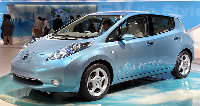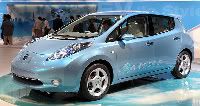Hybrid of Public/Private Financing for Renewables

But not every company that asks for money receives any at all — let alone $700 million. So exactly how does this process work? How fair is it? What criteria are most important? What types of companies are favored over others, and why? Are more mature renewables technologies, like photovoltaics (in which Solyndra plays), favored over newer ideas? (Solyndra has a very well proven breakthrough in deployment of CIGS (copper indium gallium (di) selenide), generating a significant leap in PV efficiencies and reduction in costs).
Unfortunately, it’s not clear. I suppose it’s not supposed to be. Take solar thermal/CSP (concentrated solar power) as an example of a new technology. Technologies like PV and wind have a several-decade head-start over CSP. When I interviewed industry leader Ausra‘s founder Dr. David Mills for my book on renewables, he told me that Ausra had gotten to the second round in one of these mega-contests in which the DoE selects its favorites to back, but that they didn’t make the finals. When I asked if he resented their decision, he — perhaps simply out of good sportsmanship and professional courtesy — said that he didn’t, and told me that he’ll simply try again another time.
I can’t count all the people who have asked us for our insights at 2GreenEnergy on this matter — and I regret that all I can turn up are anecdotal incidents like these. I ask readers to share their own experiences with this process so that all my learn. Thanks.



 Re: my piece on changing attitudes to electric vehicles, guest blogger Arlene Allen writes:
Re: my piece on changing attitudes to electric vehicles, guest blogger Arlene Allen writes:
 2GreenEnergy associate Bruce Allen supports oil drilling off the coast of California as a means of cleaning up the huge amount of crude and methane that are poured into the ocean every day. But of course, this idea is counter-intuitive, insofar as most environmentalists work against the idea of any and all drilling.
2GreenEnergy associate Bruce Allen supports oil drilling off the coast of California as a means of cleaning up the huge amount of crude and methane that are poured into the ocean every day. But of course, this idea is counter-intuitive, insofar as most environmentalists work against the idea of any and all drilling.
 I was just editing my book’s chapter on media, which features an interview with Sustainable Business’s Rona Fried, which made me think about sustainable agriculture — one of her favorite subjects. No sooner had a saved the file did I note an email from another person I respect greatly,
I was just editing my book’s chapter on media, which features an interview with Sustainable Business’s Rona Fried, which made me think about sustainable agriculture — one of her favorite subjects. No sooner had a saved the file did I note an email from another person I respect greatly, 
 In addition to my work at 2GreenEnergy, I’m a partner in two companies related to electric vehicles. One is the largest website on Earth dedicated to EVs — an 11-year-old website with 225,000 unique vistors a month —
In addition to my work at 2GreenEnergy, I’m a partner in two companies related to electric vehicles. One is the largest website on Earth dedicated to EVs — an 11-year-old website with 225,000 unique vistors a month — 
 Yesterday, I wrote a post featuring a
Yesterday, I wrote a post featuring a